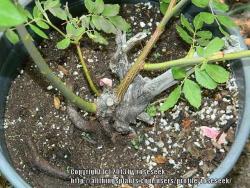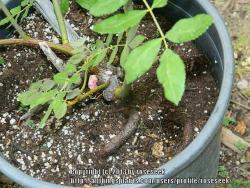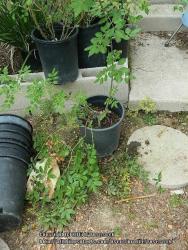There is always going to be hype. That's what drives the market and motivates many to buy one form over the other, IF there is a choice. When you over simplify the situation, and only consider a handful of variables, own root can be superior. But the same case can be made for budded. It's a much more complicated decision than many people understand. Attempting to properly explain it would confuse a lot of people even further. You shouldn't expect an honest, unbiased explanation of all the variables from the concern producing either budded or own root plants, just as you shouldn't expect an unbiased explanation of the variables involved between gas and electric from a Golden Medallion home builder. They're out there to convince you to buy what they produce. It's up to the buyer to be aware and educate themselves prior to the purchase.
When all roses were produced own root, we only had roses which performed acceptably own root. Thankfully, it has always been Nature's plan for roses (and other plants) to succeed on their own roots, without our intervention and "unnatural selection". Those which couldn't/can't, don't survive. Our selection has been tremendously greater for the past three-quarters of a century because the majority of the plants offered have been budded. We've had a very good run with them, but there are always down sides to every "advantage".
It shouldn't surprise us for some band producers to sell their wares for prices similar to the upper end budded offerings. You're correct that rooting a cutting should be far less costly than budding a plant, but there are many other factors involved. First, you must compare apples to apples. Comparing a Vintage or Heirloom band with a grocery store bare root is comparing apples to oranges. J&P and Week's probably put out the most comparable bare roots. They were well grown. There was an effort to produce them without RMV, which adds quite a bit of expense due to the need to either maintain mother blocks of indexed root stock and additional care and attention to insure VI bud wood and only using VI material. Testing and treatment of material against RMV isn't cheap. Pickering may possibly be comparable, but that also requires taking exchange rates into consideration. Why add additional confusion to juggle?
Vintage and Heirloom have much higher production costs than Burlington. You know how expensive land in Sebastopol is. Land in Visalia is much less expensive. Heirloom has display gardens and much more "professional" facilities than Burlington. Heirloom has to heat their green houses for many months due to the colder climate compared to Burlington to keep their product "retail ready". Heirloom employs a number of people, including a professional business manager. Burling is a one person operation. Vintage had the last two remaining "employees" but also had to supply money to support and repay the other partner. Taxes are significantly greater in Sebastopol than Visalia. Sebastopol requires inspection for many more pests and diseases than Visalia requires. It has many more restrictions placed on "horticulture" because the climate encourages many more pests and pathogens.
Procuring virus treated and tested material is much more expensive than simply begging cuttings. At best, the VI material availability is much more limited than untested material. Making sure both remain "virus free" requires attention, labor and time. If you're considering patented varieties, the required royalties and accounting required to track them, add costs.
Cataloging and maintaining enormous collections takes labor, space, much more water and time. Burlington beat Pickering to the punch by reducing her "collection" to what was actually viable for production and what sells. Heirloom did that a few decades ago, eliminating the extensive OGR collection they originated their business with. They found it an expensive drain on their resources for far too little reward. Vintage has never done that. Not to fault them, but maintaining a living museum requires a LOT of resources. If the business end doesn't support all the costs required, and no deep pockets step up to underwrite the efforts, failure is the ONLY option.
The one "failing" I have seen from Vintage for years was their failure to modernize their shipping. Flat Rate options simplify and often reduce the cost of sending out product. When I mail cuttings and budwood, I frequently check the weight of the packages on the self service machine in the post office. Frequently, Flat Rate is much less costly to mail a heavier package than standard Priority. I have mailed boxes for the Flat Rate price of $12.35 which would have cost up to $18 using standard Priority. I've also mailed the same size (medium) box which would have cost $12.35 Flat Rate for $5, less than the cost of the small Flat Rate box. I'm not suggesting Vintage should have weighed every package, but had they spent the little time necessary to determine which quantities of plants could have been sent Flat Rate more cost effectively than standard, they could have significantly reduced the shipping cost of the bulk of their orders, possibly resulting in more sales. Burlington has used Flat Rate for her shipments from the start. You know what it will cost for any quantity of plants and I am certain that has resulted in her selling more plants per order. There is great relief knowing you can add one or two more plants for the same shipping cost. Knowing you could add as much postage as the value of the plant inhibits buying one more unit.
Burlington also grows commercially by contract for other nurseries, operating the rose business as a sideline. Her climate is highly conducive to own root production, particularly for those varieties which root more easily and grow well own root. Sebastopol, in comparison, isn't nearly as own root friendly as Visalia because of climate. What can be rooted out doors and left pretty much on "automatic" to mature, requires covered hoop houses with much greater attention in Sebastopol. That climate also requires much more chemical intervention against pests and diseases than Visalia does. That adds significant costs in materials, labor, inspection and regulations.
While the "market" may have supported charging higher prices, and a bit more profit may have been possible, Burling consciously chose her pricing to keep her roses more affordable to build her client loyalty.
Heirloom reportedly offers more VI type plants. They cost more. They offer mor patented varieties. They cost more. Vintage and Heirloom imported roses to offer things not available elsewhere. Current regulations for importing impose many hundreds of dollars in inspection fees per shipment. If you are fortunate to live near a smaller, less 'security risk' entry point, you may be able to walk your own material through the process. If, like me, you live near a high risk entry point, you MUST pay a USDA employee over time rates to handle that for you. I have heard of instances where that added a thousand dollars to the whole shipment, in addition to nearly $600 in inspection fees and treatment. $150 worth of roses and postage cost nearly $2,000. Add up to four, possibly more, bi annual inspections, which cost a minimum of $80 (maximum $500) each, depending up the distance required from their office to your location and the hours needed for inspection, and it really adds up. I investigated importing roses I wanted from Europe. I could count on needing nearly $1500 IN ADDITION to the cost of the roses and postage, for less than ten plants from one source. Additional sources require duplicate costs, except for the bi annual inspections. Then, those plants must be held a minimum of ten feet from anything in the Genus Rosa for up to two years while in quarantine. The local Ag Agent must be given access to them, with your presence, up to four times in two years. The Vintage French imports required more inspections and more time than the two year quarantine period, not because they found anything, but because the plants imported failed to thrive. The Ag Agent chose to err on the safe side, but that also added to the costs and postponed the sale of the product. Burlington won't deal with any of that. It costs too much, demands too much of her time and energy, preventing her from doing her business.
There are valid reasons why some sources produce much higher cost plants than others. Even if they are offering the SAME rose, Heirloom's and Vintage's plant will cost more than Burlington's. Plus, IF they are going to offer a product in the first place, aren't they justified in expecting to be able to earn a living from it? Own root should cost less than a budded plant because it is smaller, younger and requires less time and land to produce. The reality is, you have to sell MANY more less expensive plants to be able to pay the electric bill (much less all the other costs of living). Those who operate nurseries do it because they love it, but it won't support them. Particularly when their loyal customer base continually snaps up the inferior grocery store and big box store "cheap plants" in the hopes of "getting a deal". Not even Burlington can compete with that. Kim


